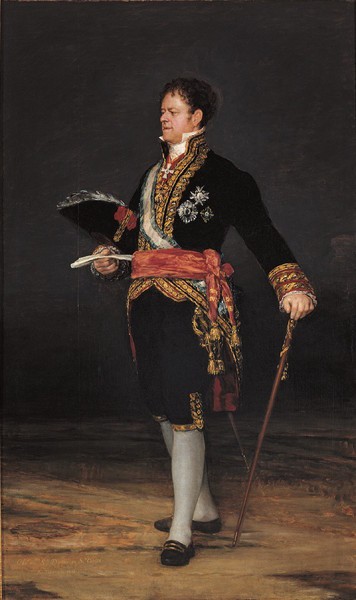- Cronología
- 1815
- Ubicación
- Museum of Zaragoza, Zaragoza, Spain
- Dimensiones
- 237 x 153 cm
- Técnica y soporte
- Oil on canvas
- Reconocimiento de la autoría de Goya
- Documented work
- Titular
- Imperial Canal of Aragon (Ebro Basin Water Authority)
- Ficha: realización/revisión
- 19 Apr 2010 / 11 Dec 2024
- Inventario
- en depósito
El Ex.mo S.or Duque de S.n Carlos / por Goya año 1815 ("His Excellency Señor Duke of San Carlos, by Goya, 1815", lower left-hand corner).
From December 5th, 2024, and while the Zaragoza Museum remains closed for works, the painting is part of the exhibition 'Goya. From the Museum to the Palace' in the Aljafería Palace in Zaragoza.
See Ferdinand VII.
José Miguel de Carvajal, Vargas y Manrique (Lima, 1771-Paris, 1828), Duke of San Carlos, Count of Castillejo and El Puerto, had connections to Ferdinand VII when the monarch was still Prince of Asturias. Back then he was the prince's assistant and was by his side during the Aranjuez uprising against Godoy and the Escorial conspiracy. When Ferdinand VII came to power he became palace steward, and Secretary of State when the court returned to Spain in 1814. The king's favour would also see him appointed lifetime director of the Bank of Spain and director of the Spanish Royal Academy.
In Goya's full-length portrait of him he is shown in gold braided black military dress, white stockings, with a striking red sash around his waist, and numerous medals and decorations pinned to his dress coat: the Golden Fleece, the sash and insignia of the Order of Charles III, and others. His right arm cradles his hat and he is holding a letter in his hand, whilst his left hand, further away from his body, rests on a baton, giving the duke's pose a distinguished air.
His face is the most accomplished part of the work, realized from a life study that now belongs to a private collection in Madrid. In fact, still visible in the painting, underneath the head, are the pencil marks that Goya made when drawing the grid he used to transfer the composition from the study to the final work. The slightly squinting eyes, as if struggling to focus, alludes to the duke's short-sightedness. His myopia even led him to lose his post as Secretary of State, or so alleged his beloved Ferdinand VII, who later appointed him to diplomatic posts abroad. His face, seen here in profile, plays down this defect, along with others of his less than handsome physical appearance, such as his pronounced lower jaw and hooked nose, which Goya has toned down within the limits permitted by realism. The low viewpoint which makes the figure appear larger than life, the noble pose and the elegant finish on the details of the clothing all make it clear that this portrait is a gesture of gratitude from Goya to the model, who spoke out in the artist's favour to help exonerate him from the suspicions of the inquisition.
-
Exposición Hispano-FrancesaZaragoza1908
-
GoyaMinistry of Foreing AffairsBurdeos1951organized by the Bordeaux City Hall, consultant editor Gilberte Martin-Méry. From May 16th to June 30th 1951cat. 45
-
Goya y el Mundo ModernoMuseo de ZaragozaZaragoza2008organized by the Fundación Goya en Aragón at the Museo de Zaragoza, consultant editors Valeriano Bozal and Concepción Lomba Serrano. From December 18th 2008 to March 22nd 2009cat. 7
-
Goya e il Mondo ModernoPalazzo RealeMilan2010organized by SEACEX, Palazzo Reale and Fundación Goya en Aragón, consultant editors Valeriano Bozal and Concepción Lomba Serrano. From March 17th to June 27th 2010cat. 9
-
Realidad e imagen. Goya 1746 – 1828Museo de ZaragozaZaragoza1996consultant editor Federico Torralba Soriano. From October 3th to December 1st 1996cat. 63
-
Goya en tiempos de guerraMuseo Nacional del PradoMadrid2008consultant editor Manuela B. Mena Marqués, from April 14th to July 13th 2008cat. 159
-
El Canal Imperial de Aragón (1528-1985)Centro de Exposiciones y Congresos IbercajaZaragoza1985from Januaty 21st to March 23th 1985
-
Goya: The PortraitsLondon2015cat. 59
-
Goya. From the Museum to the PalaceZaragoza2024cat.119
-
L'œuvre peint de Goya. 4 volsParís1928-1950vol. II, p. 201, cat. 490
-
Breve historia de dos GoyasSeminario de Arte AragonésZaragoza1952pp. 93-98
-
Vie et ouvre de Francisco de GoyaParísOffice du livre1970pp. 297, 376, cat. 1542
-
L’opera pittorica completa di GoyaMilanRizzoli1974p. 129, cat. 590
-
Francisco de Goya, 4 vols.ZaragozaCaja de Ahorros de Zaragoza, Aragón y Rioja1980-1982vol. IV, p. 35 y p. 44 (il.)
-
Museo de Zaragoza. GuíaZaragozaGobierno de Aragón2003p. 342 y p. 343 (il.)
-
Goya en tiempos de guerraMadridMuseo Nacional del Prado2008p. 440, cat. 159 y p. 441 (il.)
-
LondonNational Gallery Company2015pp. 177-179
-
Goya. From the Museum to the PalaceZaragozaZitro Comunicación2024pp.118-119
